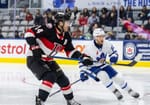There was a time, last season, when the Toronto Marlies were the perfectly crafted developmental tool.
Not only had Kyle Dubas and Leafs management constructed the best Marlies team in franchise history, a roster that cruised to a 14-point margin as the American Hockey League’s best with 114 points and a 54-16-6 record, but they did it with one of the youngest groups in the league.
There were veterans spattered throughout the lineup (Mark Arcobello, Rich Clune, Ben Smith, and Matt Frattin, to name a few), but the Marlies rose -- and eventually fell -- on the backs of the Leafs’ brightest young talents. William Nylander was the team’s best player and the most lethal offensive weapon in the AHL. Connor Carrick was their best defenceman in the playoffs. Josh Leivo, Connor Brown, Nikita Soshnikov, Kasperi Kapanen, Brendan Leipsic, and Zach Hyman rounded out a young core that was used in prominent roles as head coach Sheldon Keefe’s go-to options.
They were fun to watch, they were dominant, and they were building towards a clear destination, one focussed on development first. Success came, but it wasn’t the be all and end all of what the Marlies were trying to accomplish.
A year later, they were a decidedly different team, with a murkier path.
Things change. These Marlies were not those Marlies. Toronto fell from first in the AHL to 13th, on route to a still-respectable 42-29-5 record. Part of the change was unavoidable, as personnel moved down that aforementioned path.
But these Marlies felt the pain of an organization that shifted attention to the success of its big club, at the cost of its affiliate’s ability to properly develop — at least in the truest sense.
They lost all of Nylander, Soshnikov, Brown, Carrick, and Hyman to full-time roles with the Leafs — a positive. If the Marlies were to suffer at the hand of their own job-well-done, that was fine.
But these Marlies were hindered in other ways. For the two years prior, while the Leafs tried to add young talent and draft picks, they also often took on aging salary. This season, most of those dead contracts caught up with the Marlies.
Rather than replacing the Marlies’ top young talent with some of the organization’s other bright young prospects (like centre Adam Brooks on a roster bereft of depth down the middle), the Leafs’ AHL affiliate was often forced to roster the contracts they couldn’t shed. That meant the likes of Colin Greening (who is actually a serviceable AHL veteran), Brooks Laich, and Milan Michalek factored in for stretches of the season in roles they might not have otherwise played a year earlier.
There were silver linings, amid it all, though. Kapanen blossomed, as a teenager and then as a 20-year-old. Sheldon Keefe believed enough in Carl Grundstrom, when it would have been easier to sit the newcomer in favour of a more familiar veteran, and it paid off — Grundstrom thrived in a brief playoff stint.
And while the Marlies added the likes of Andrew Nielsen, Travis Dermott, Andreas Johnsson, Trevor Moore and Dmytro Timashov to the lineup full-time, the latter two were pushed to the fourth line and didn’t develop like the organization probably would have hoped. (This is particularly true for Timashov, who was a year removed from being a standout in training camp and star at the World Juniors and in the QMJHL.)
Later in the season, in order to be more competitive and find their way into the playoffs, the Marlies added other aging AHL veterans and lineup staples Cal O’Reilly (on loan from the Rochester Americans) and Sergey Kalinin, neither of whom have a future with the Leafs.
In net, the organization experimented with stop-gap options such as the injured Karri Ramo, in hopes of helping the big club, at the expense of their younger goalies.
Rather than using their veterans as fillers for the Leafs, like they did a year earlier to insulate and keep the young talent in the AHL, the Marlies opted against promoting a former NHL player like Greening in order to give not-yet-ready options such as Frederik Gauthier a shot in the NHL.
These Marlies were designed like most AHL teams are: feed the NHL beast, and worry about the rest later. They weren’t different, at least not to the same degree they have been. But that’s the price most NHL teams pay for their success. And it’s a sign the Leafs are ready to shift their attention to the prize at the end of their rebuilt tunnel.




Comment Navigation & Markdown
Navigation
cc to focus on comments section
c next comment
x previous comment
z next unread comment
Inline Styles
Bold: **Text**
Italics: *Text*
Both: ***Text***
Strikethrough: ~~Text~~
Code: `Text` used as sarcasm font at PPP
Spoiler: !!Text!!